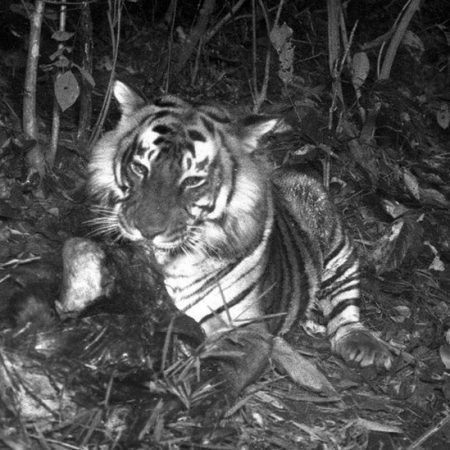A Champion of the Tiger’s cause
This section details how one photographer and conservationist, F W Champion (1893 – 1970), campaigned for the protection of tigers and other wild creatures, as well as their habitats, in the 1920s and 30s. It is written by his grandson, James Champion, who has spent many months retracing his grandfather’s footsteps in India, meeting and discussing with many of today’s tiger specialists, and finding out just what kind of legacy his grandfather’s pioneering work has left.
‘We had only gone a few paces when once again the tiger shot out and vigorously slapped a beater across the head, tearing away half his scalp.
As he fell, the tiger jumped onto his back and tore his coat to shreds, springing round again and biting viciously at his legs. None of us dare shoot lest we perchance hit the beater. But in the next second, the tiger leapt off and as he did so, two reports rang out into the silent forest air. The tiger fell to the ground writhing in its death struggles, rolling to the bottom of the valley and lying still.
My shot had gone through its heart and my brother’s through the head. Cautiously we approached,,and then we had the only joke of the day. We discovered that my brother’s shot of the previous evening had broken the jawbone, and this alone had saved our lives.
But danger has its thrills and consequently its attractions, and the incident has only made me long for a repetition of similar excitement. It is not courage, it is just madness – but it is an ecstatic madness withal.’ (Niblett, undated).
The tigress described so vividly above met her end not because she was a man-eater, but simply to satisfy the bloodlust of two young gentlemen, and suffered a grim and painful night of suffering before she faced the final bullet. Such attitudes towards wild creatures were the norm in India throughout the eighteenth, nineteenth and early twentieth centuries, but one early conservationist, Frederick Walter Champion (1893 – 1970), took on the task of challenging such behaviour, pre-dating other reformed hunters such as Jim Corbett.
F W Champion (FWC) became one of India’s first campaigners for wildlife protection at a time when his contemporaries saw large mammals as targets for the rifle rather than as creatures with a right to exist. He was also the pioneer of tripwire photography, which later developed into what is now known as camera-trapping, one of the key tools in modern conservation. His astonishing images have stood the test of time, and continue to inspire young conservationists and wildlife photographers in India today.
OVERVIEW OF FWC’s EARLY LIFE:
FWC was born on 24 August 1893 at Horsell, Woking, Surrey. His father, George Charles Champion (1851 – 1927), was a professional entomologist employed by the eminent Victorian naturalists Frederick Godman (1834 – 1919) and Osbert Salvin.(1835 – 1898). George Charles had spent the years 1879 to 1883 as an insect collector in Guatemala and Panama, travelling by mule through some of the wildest parts of Central America. Over the course of his career he described more than 4,500 species new to science.
With such a background, it is hardly surprising that wildlife featured prominently in the adult lives of FWC and his siblings, and he spent much of his free time as a child on nearby Horsell and Chobham Commons. It was here that he developed a passion for nature and particularly wildlife photography. At seventeen, he achieved one of his early ambitions, to photograph a Nightjar at its nest. He was particularly fascinated by these mysterious nocturnal birds.

A Nightjar photographed by FWC in 1910
FWC wrote a detailed diary through the year 1910 (now held in the Champion family’s private archive), recording all of his early failures and later successes with the camera. Photography in those days was very much a hit-or-miss affair, as his entry for 22 January 1910 shows:
I took four photos of tits, but only one, a coal tit, came out successfully, the others I tried to get too large and as a result they were only partly in focus, thereby wasting 9d, which shows how expensive experience is. While focussing my camera, with my head under the cloth, about two feet from the fat, a coal tit had the audacity to come and enjoy a meal as though I were not there. This shows how tame birds will become under kind treatment.
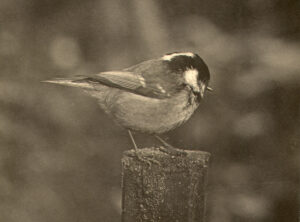
F W Champion’s desire to protect animals – and not just observe them – was becoming evident. He was dismayed by the desire that prevailed in those days to destroy many wild birds, particularly predators. On 7 May he wrote:
In the afternoon went to the owlery [a Tawny Owls’ nest that he had been photographing] and to my great sorrow, found that they had gone. As they were too small to fly, they must either have been destroyed by a gamekeeper or taken by somebody else.
An entry a few months later, on 22 September, reads:
There are two stuffed young brown owls in Bradden’s [the taxidermist’s] at Guildford, which are just about the same size as mine were when they disappeared, so I think it probable that this is the explanation for their disappearance.
It was not long before FWC’s photographic skills achieved recognition, winning him a 7/6 d prize for a print of a Mistle Thrush’s nest. It was the first time he had won anything for his photography, and his modest diary entry records: “I suppose I must be improving a trifle.” One aspect which distinguishes today’s instant digital photography from that practised in those early days is the fact that it was not possible to see what results had been achieved until the plates had been developed in the darkroom. Frustration at successive poor prints led him to declare in September:
Have got the hump of photographing, or rather, trying to photograph, birds in the garden. It’s merely a waste of time and money, as I never by any chance get a decent negative.
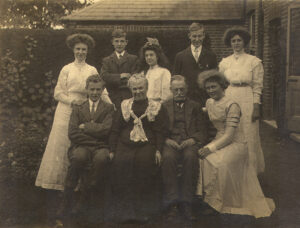
In 1913, immediately after completing his studies at Guildford Grammar School, FWC enlisted in the Indian Police. This was the only way he could find of accomplishing his desire to obtain the first photographs of a tiger in the wild. However, he did not find police work very congenial and, when the First World War broke out, he took the opportunity to join the Indian Army and was commissioned into the Cavalry. Thereafter he volunteered to be seconded to the Kurram Militia and spent much of the War on the North-West Frontier, fighting in the Third Afghan War.
There were few opportunities during that time for wildlife photography, and indeed he went along with many of his fellow officers in hunting Markhor, the magnificently horned wild goats of the Safed Koh mountains. In 1919 he was demobilised in the rank of Captain, having been Mentioned in Despatches.

Captain FWC in the Safed Koh mountains, 1919
At this time there was a shortage of trained foresters in India due to the loss of manpower during the war, and the newly demobilised F W Champion obtained a scholarship to read forestry at New College, Oxford. He graduated top of his class in a post-war shortened course in 1922. Champion then joined the Indian Forest Service in the (then) United Provinces, his first posting being in the Lansdowne Division, in the foothills of the Himalayas. In 1923 he married Julia (Judy) Stewart, who later accompanied him on his tours of inspection through the forests and assisted ably with his photography and writing. The Forest Service provided unrivalled opportunities for him to pursue his lifelong interest in wildlife photography, and he finally came closer to achieving his great photographic ambition.
CONVERSION FROM HUNTING TO PHOTOGRAPHY:
It was at this time that Champion abandoned the use of the rifle and the shotgun – except to provide occasional additions to the camp food supply – and hunted armed only with the camera. He also progressively developed his technique for taking photographs of wildlife by night, using flashlights and a tripwire.
During his service in India, Champion wrote two books – With a Camera in Tiger-land (1927) and The Jungle in Sunlight and Shadow (1934) – both published by Chatto & Windus. He also wrote numerous articles on wildlife photography for publications including The Illustrated London News, The Field, Country Life and The Indian State Railways Magazine, criticising sport hunting, encouraging the use of the camera rather than the gun, and pressing for conservation. He also advocated the humane treatment of captive animals, and campaigned strongly for what would be seen today as animal rights issues.
Though largely forgotten in the UK today, FWC’s photographs appeared widely in magazines and periodicals during the period 1920 – 1950. The Illustrated London News even placed one of his tiger images on its front page in 1940, when the capital had been blitzed by German bombs and one would have expected other more pressing issues to take priority. His images were even used by ‘pro-hunting’ publications such as Country Life and The Field, which enabled FWC to put across his appeals for greater restraint in sport hunting.

ILN front cover
FWC’s ATTITUDES TO HUNTING AND PRESERVATION OF WILDLIFE:
A series of quotes from F W Champion’s writings reveals his remarkably modern attitudes towards the hunting of wild animals, attitudes which brought him into conflict not only with his peers but also with his superiors, most of whom were keen hunters themselves. For example, in his Introduction to With a Camera in Tiger-land (Champion, 1927) he states:
‘So many books have already been written on the subject of big-game hunting in India that there remains little or no room for another. These books have, however, nearly all been written with the object of describing adventures which culminate in the climax – or anti-climax, according to one’s nature – of destroying the many and beautiful creatures which form the object of pursuit; and in almost every case, they have been illustrated with drawings, paintings or photographs of dead animals, which very rarely give a true representation of the denizens of the Indian jungles as they really are.’ (Champion,, 1927)
In his description “An extraordinary experience with a tigress”, in With a Camera in Tiger-land, he notes:
‘One often hears people speak of how beautiful such-and-such an animal looked before he died, but surely nobody with a real love of the beautiful in Nature can care for the subsequent skin or head, often grotesquely mounted and bearing no resemblance to the animal before death, when it is possible by photography to obtain life-like reproductions of the actual scenes. Such pictures, hanging on one’s walls in subsequent years, bring back vividly, as no skin or head can ever do, what may have been the most thrilling moments of one’s life. Surely, looking at the photographs, one can half close one’s eyes and see not photographs, but real scenes. One can feel again the warm air and hear the hum of the insects; one can see the shifting sunlight as the mid-day breeze stirs the leaves and throws the tiger into alternate light and shade; and lastly, one can see the living, breathing tiger as he lies, having no final vision of the magnificent king of the jungle lying in his death agony to mar the pleasure of a wonderful experience.’ (Champion, F W, 1927)
He wrote “A Plea for the Indian Blackbuck” in Country Life,(Champion, 1934), stating:
‘Blackbuck still occur in fair numbers in more distant places, but every year they seem to be getting fewer and fewer, and it is doubtful if there are now ten percent of what there were fifty years ago. This destruction of one of the finest antelopes in the world is increasing annually, and one begins to wonder if the unfortunate blackbuck is doomed to follow the fate of the bison of America, and of other creatures, once existing in countless numbers, that have now disappeared from the world. It is only in recent years, with the vast increase of gun licences all over the country and the advent of the motor-car, that real and systematic destruction has begun, and one dreads to contemplate where it is likely to end. A modern motor-car with high clearance can be driven over most of the country frequented by blackbuck, and it is now becoming a more and more common amusement of so-called ‘sportsmen’ to shoot these antelopes from a car, which the animals have not yet learned to fear. Only a month or two ago – here in Oudh, where I am writing this – a certain landowner took out a car and shot nine bucks in two or three hours, although he was a wealthy man and did not require the meat or skins, nor were any of the horns of a size to make the heads worth keeping as trophies. I remonstrated with him, but he did not seem to be able to realise that such murder could not possibly be included under the title of ‘sport’, nor could he appreciate what a bad example he was setting to others. This sort of thing is now being done all over India.’ (Champion, Country Life, 1934)

Blackbuck
In an account entitled “Photographing Swamp Deer” in his book The Jungle in Sunlight and Shadow, his love of Indian wildlife comes across strongly:
‘India provides a magnificent field for the animal or bird photographer, and there are literally hundreds of different kinds of birds which have never yet been successfully photographed in the wild state. The pursuit of such photographs provides an absorbing hobby, full of difficulties, full of disappointments, but always with the chance of splendid prizes dangling before one’s eyes; and yet the number of really keen and successful animal or bird photographers in India is so small that they could easily be counted on the fingers of one’s hand. I have never been able to understand why nature-photography does not become more popular in a country where every other Britisher is keen on shikar [hunting] – keen to such an extent that no hardship, no privation is too great, provided only that the unfortunate quarry is ultimately brought to bag. Surely the atavistic lust to kill ought to become satiated sooner than it does; surely a living animal is far, far more interesting than a bloody carcass; surely those of us who went through the Great War saw quite enough of Death and all its horrors for one lifetime; and surely, oh! surely the innumerable difficulties that beset the animal-photographer at every turn should act as a spur to men who will never admit fatigue or defeat when hunting to kill. And yet the animal photographer in India is as scarce as he was ten years ago, and one begins to think there must be some truth in the Frenchman’s alleged description of the Englishman, who is said to greet the morning with “By Jove, what a beautiful day! Let us go out and kill something.” And then there are the Hindus and Buddhists and other great races of this vast country, whose very religion prohibits them from taking life. Surely some among these numerous Indians must feel drawn towards the excitement of the hunt, the pitting of the wits against those of the denizens of the wild, the study of the beautiful creatures that inhabit the country of which they are so proud! Animal photography is obviously the hobby for them – a hobby that does not entail the spilling of a single drop of blood…’ (Champion, , 1934),
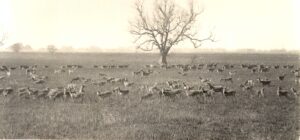
Swamp deer
PHOTOGRAPHIC TECHNIQUE:
Much of FWC’s photography took place in what are now the Rajaji, Corbett and Dudhwa National Parks, including many shots of tigers and other large predators, and gharial (Gavialis gangeticus), also known as the gavial (a now critically endangered fish-eating crocodile native to the Indian Subcontinent). His technique involved identifying, by the presence of pugmarks and other traces, the tracks that were regularly being used by tigers or other nocturnal animals. His large and cumbersome (by modern standards) Kershaw-Soho Tropical Quarter Plate camera would be carefully positioned next to the path, camouflaged with leaves and branches, connected to a battery and a magnesium flash with a tripwire across the path, the lens would be focussed on precisely where the animal’s face should be if it came along in the desired direction, and then left until the following morning.

FWC’s Kershaw camera
Sometimes the apparatus would be positioned close to a recent kill, and a series of cut bushes or branches would be carefully arranged so as to guide the tiger in the most photographically suitable direction. In this respect, FWC’s approach was much the same as modern camera trapping, which continues to rely on a combination of bushcraft, elements of behavioural ecology and luck. For FWC, however, the available technology meant that this was very much a hit and miss affair. As only one glass-plate negative could be exposed per night, it was some time before Champion achieved anything satisfactory in the way of pictures. An extract from FWC’s photographic diary from 1926 (now held in the Champion family archive) reveals the great difficulty he experienced in his quest to obtain satisfactory images of tigers and other wildlife:
Kotdwara 27-10-1926
A tigress in Lalpani attacked some graziers’ cattle in the evening as they were returning home and finally killed a full grown buffalo giving milk (our milk supply) and seriously injured in the neck a second.
Put up the flash and also sat in a machan with the idea of shooting her if possible as she had done so much damage, and, if not to get a photo. Completed arrangements about 3.30 and nothing happened for about 2 hours except for crows trying to come down on the kill and the frequent approach of jungle fowl. These latter were often running about near the tripwire and I expected them to fire it off every minute, but somehow or other they failed to do so. At about 5.30 a kakar called a long way away up the hillside and later langoors, and finally both sambar and langoors began calling violently as she came nearer and nearer towards dusk. Just as it was getting dark the tigress came down for a drink just out of sight behind me, and I heard her lapping the water very distinctly. Shortly afterwards my elephant arrived and the tigress retreated up the hill again. I therefore got out of the machan as quietly as I could and we left the place without speaking a word, hoping that the tigress would think that the elephant was a wild one. This she apparently did, and the flashes were fired off in the morning, the signs suggesting that she had come just as I had hoped, and had produced an excellent picture.
We developed the plate with great hopes in the evening, and bitter was our disappointment to find that no light whatever had reached it. This seems extraordinary, being the third time that it has happened, and I am at a loss to account for it. I am sure that everything was set all right and the only solutions I can think of are:
- I knocked the shutter down when putting the camera covers on – I had a faint suspicion of this at the time
- The wind knocked some twig on to the shutter in the same way.
I had hoped that we were going to start the season well with this picture – which would have been one of our best had it come off – but last year’s game of continuous failures is starting again.
On further consideration, I think that reason no 1 accounts for this failure and I have now made a tin cover to protect the shutter wire.
FWC was also among the first to recognise that photography could be an aid to assessing the movements and population trends of tigers, as he recognised that each individual animal has its own unique pattern of stripes. This technique, now known as ‘spatial capture – recapture’ is used extensively to assess species abundance in contemporary camera trap studies.
INFLUENCE ON JIM CORBETT AND A LASTING LEGACY:
FWC was, by all accounts, a large, ebullient man with strong opinions, particularly about wildlife conservation, and he did not shy away from expressing his views. As such, some people found him rather intimidating. His opinions were generally not fashionable at the time and were not always popular with his contemporaries, many of whom were ‘sportsmen’. Nevertheless, his contribution to wildlife photography and conservation in India should not be underestimated.
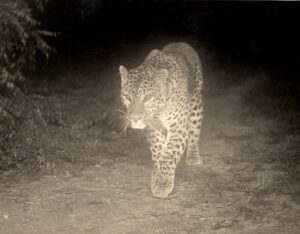
A ghostly leopard
Among the contributions he made were, perhaps most obviously, convincing the well-known hunter Jim Corbett to turn, at least to some degree, away from the rifle and towards the camera. The two men enjoyed a friendship that lasted until after both had moved to East Africa. Champion had already long since turned his back on hunting, and he tried to persuade Corbett to follow a similar path, as documented in the final chapter of Man-eaters of Kumaon:
“It was looking at the photographs in Champion’s book, With a Camera in Tiger-land, that first gave me the idea of taking photographs of tigers.” (Corbett, 1947)

A tiger about to spring at the camera
Both Champion and Corbett served together on the Steering Committee for the founding of the Hailey National Park, India’s first, in 1936. Following on from this, a network of further protected areas was set up, the heritage of which can be traced back to Champion’s campaigning in the 1920s and 1930s. Champion’s legacy also includes the conditions in which captive animals are kept, he was deeply moved by the suffering of animals in captivity, and became involved in the founding of Whipsnade Zoo, where captive animals were for the first time given larger, more naturalistic and stimulating enclosures.
Champion also wrote about the impact photographers can have on wild animals, as shown in a plea he wrote in an article entitled Big-game Photography for Beginners, ‘Never, however great the temptation may be, cause a bird to desert its nest, or an animal its cubs, in your efforts to take better photographs’ (Champion, The Field, 1936). This subject has become even more relevant in recent years, with the proliferation of digital cameras, and amateur photographers willing to put disturbance concerns below the desire to obtain ever better and closer shots. He was conscious of this even in the 1930s.
Whilst most of his contemporaries reserved all their interest and attention for large and spectacular quarry, Champion wrote extensively about less charismatic animals including vultures, ratels (honey badgers), squirrels and pangolins, providing in some cases the first written accounts of the ecology of these animals. This led to a wider interest in the ‘more obscure’ animals, which may well have contributed in turn to a greater public awareness of the need to protect entire ecosystems.
As the late Kailash Sankhala, the first director of Project Tiger said, “F W Champion was the true pioneer of tiger conservation in India, not Jim Corbett: Corbett, who gave such horrifying accounts of man-eaters, also described the tiger as a “gentleman”. He pleaded for its conservation, yet he himself became the director of a hunting safari company in Kenya. I am unable to understand such contradictions. If the tigers of Corbett Park had the franchise, I feel sure they would have voted for the Park to be associated with the man with the old plate camera, F W Champion, who inspired so many to give up the gun for the camera, including myself.” (Sankhala, K, 1978)
Although it is hard to quantify the contribution of Champion towards the change in attitudes to wildlife in India, the above quote from Kailash Sankhala is testament to his lasting legacy. Whilst the tiger remains threatened in India, with population pressures and poaching to satisfy the traditional Chinese medicine market still causing significant concern, they still roam in the three great national parks that now contain areas that he worked hard to protect in the 1920s and 30s, and the techniques that he pioneered are now being used to help conserve the animals that he campaigned so tirelessly to protect. Indeed, many of today’s researchers who use this technique were inspired themselves by the astonishing images that the man with the old plate camera, F W Champion, had obtained so painstakingly nearly ninety years before.
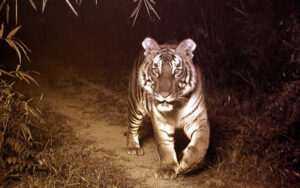
F W Champion’s most famous image
References
Champion, F W, 1927, With a Camera in Tiger-land, Chatto and Windus, London
Champion, F W, 1934, The Jungle in Sunlight and Shadow, Chatto and Windus, London
Champion, F W , 1936, Big Game Photography for Beginners, The Field, 5th September
Champion, F W, 1947, A Plea for the Indian Blackbuck, Country Life, 14th July
Corbett, 1947), Man-eaters of Kumaon, 1947, OUP, Oxford
Niblett, undated, In the Indian Jungle, India in Fable, Verse and Story, Thacker & Co, Bombay.
Sankhala, K, 1978, “Tiger! The Story of the Indian Tiger”, Collins, Glasgow.

